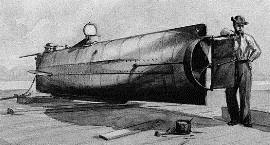The Anchors Aweigh series was placed in honor of the men of the
US Navy who have served in the defense of our country. Each cache
is dedicated to one of the warships involved in battle. If you find
all the caches in the series, you’ll reveal some nice GeoArt
on your cache map. These are not difficult caches to find. If you
cannot find a cache easily, it’s probably missing. Send me a
picture (by email, not in your log) of where you think the cache
should be, and I’ll accept the find and replace the
cache.
Because of the difficulty in finding suitable locations for some
of the caches, some puzzle caches were used (not this one) so that
the find icon could be in a location separate from the cache. You
should be able to solve the puzzles with information on this cache
page. I suggest you solve the puzzles before you make your cache
run, to help optimize the route.
CSS Hunley
H.L. Hunley was a submarine of the Confederate States of
America that played a small part in the American Civil War, but a
large role in the history of naval warfare. The Hunley
demonstrated both the advantages and the dangers of undersea
warfare. It was the first combat submarine to sink an enemy
warship, although the Hunley was not completely submerged
and was lost at some point following her successful attack. The
Confederacy lost 21 crewmen in three sinkings of the Hunley
during her short career. The submarine was named for her inventor,
Horace Lawson Hunley, shortly after it was taken into service under
the control of the Confederate Army at Charleston, South
Carolina.
H. L. Hunley, nearly 40 feet long, was built at Mobile,
Alabama, and launched in July 1863. It was then shipped by rail on
August 12, 1863 to Charleston, South Carolina. Hunley (then
called Fish Boat) sank on August 29, 1863, during a training
exercise, killing five members of her crew. It sank again on
October 15, 1863, killing all eight of her second crew, including
H. L. Hunley himself, who was aboard at the time, even though he
was not enlisted in the Confederate armed forces. Both times the
Hunley was raised and returned to service. On February 17,
1864, Hunley attacked and sank the 1240-short ton screw
sloop USS Housatonic on Union blockade duty in Charleston's
outer harbor. Soon after, Hunley sank for unknown reasons,
killing all eight of her third crew. This time, the innovative ship
was lost, until being rediscovered in the late 20th century. It was
raised from the ocean floor on August 8, 2000, and is on display at
the Charleston Naval Yard in North Charleston, South Carolina.
Attack on the USS Housatonic

CSS Hunley
Hunley made her first and only attack against a live
target on the night of February 17, 1864. The vessel was the USS
Housatonic. Housatonic, a 1240-ton steam-powered
sloop-of-war with 12 large cannons, was stationed at the entrance
to Charleston, South Carolina harbor, about 5 miles out to sea. In
an effort to break the naval blockade of the city, Lieutenant
George E. Dixon and a crew of seven volunteers attacked
Housatonic, successfully embedding the barbed spar torpedo
into her hull. The torpedo was detonated as the submarine backed
away, sending Housatonic and five of her crew to the bottom
in five minutes, although many survived by boarding two lifeboats
or by climbing the rigging until rescued.
After the attack, Hunley failed to return. There is
evidence that Hunley survived as long as an hour after the
attack, which took place at approximately 8:45 p.m. The commander
of Battery Marshall reported the day after the attack that he had
received "the signals" from the submarine indicating it was
returning to her base. The prearranged signal, from a blue carbide
gas signal lantern, was received at around 9:00 p.m. at Fort
Moultrie on Sullivan's Island. The signal was also seen by crew
members of Housatonic who were in the ship's rigging
awaiting rescue. This type of lantern cannot be seen at distances
beyond about one and a half miles, indicating that the submarine
had come fairly close to shore after the attack on Housatonic.
After signalling, Dixon would have taken the sub underwater to
try to make it back to Sullivan's Island. What happened next is
unclear. The finder of the Hunley suggested that the
submarine was unknowingly rammed by the USS Canandaigua,
which was coming to the rescue of the Housatonic's crew.
One possibility is that the torpedo was not detonated on
command, but rather malfunctioned due to damage incurred during the
attack. It was intended that the torpedo be detonated when
Hunley had retreated, playing out its detonation rope, to
approximately 150 feet from the target, to minimize damage to the
sub. However, witnesses aboard Housatonic uniformly stated
that the submarine was no more than about 100 feet away when the
torpedo detonated. This is because the crew of the Hunley
were fighting the waves, so they stopped one hundred feet away from
the Housatonic to wait until the current could carry them
away. The crew of the Housatonic fired on the Hunley,
and one man hit the detonation box with his pistol. This caused the
explosion that sank the Housatonic and may have damaged the
Hunley.
In October 2008, scientists reported that they had found that
Hunley's crew had not set the pump to remove water from the
crew compartment, which might indicate that it was not being
flooded. "It now really starts to point to a lack of oxygen making
[the crew] unconscious," the chairman of the South Carolina
Hunley Commission said. "They may have been cranking and
moving and it was a miscalculation as to how much oxygen they
had."
Her crew perished, but Hunley had earned a place in the
history of undersea warfare as the first submarine to sink a ship
in wartime.